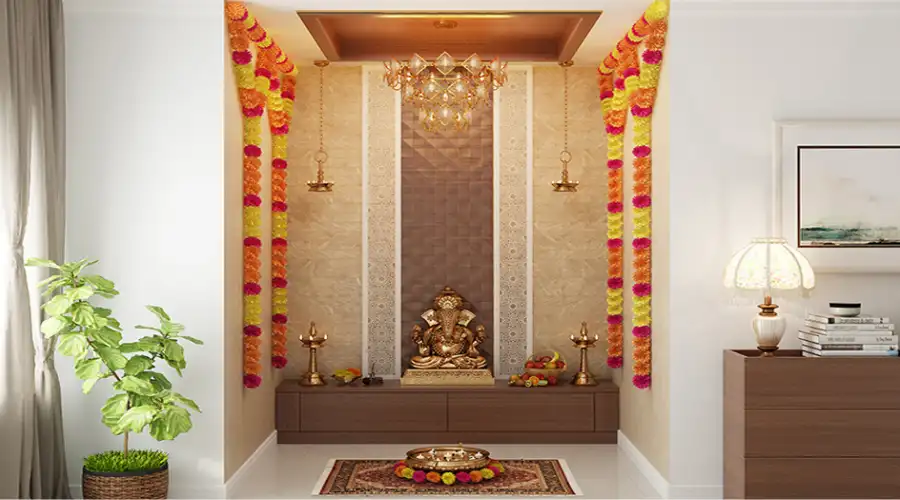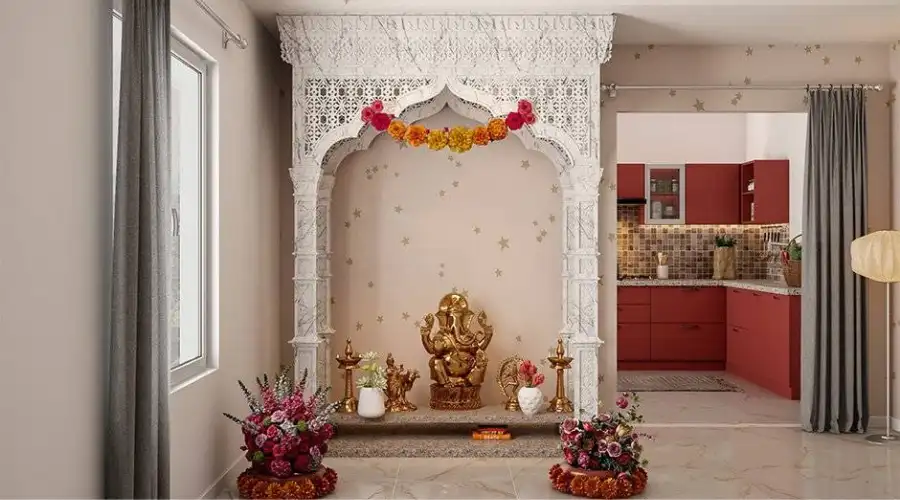According to Indian culture, the pooja room or mandir unit occupies a crucial place in the house. Placing the mandir unit in the ideal place may help one to worship the deities with satisfaction. In every religion, a mandir unit is a place that is sacred and holy, from where one gets most of the positive energy. Vastu Shastra provides guidelines for placing the best spot for a mandir unit in homes. Each direction has its meaning and energy. For example, the North symbolises wealth and success, while the South represents health and long life.
The northeast, or Ishan Kona, is the best direction for a mandir at home. This direction is linked to Lord Ishaan, a Hindu deity lord Shiva known as Dikpala, and symbolises knowledge and wisdom. Placing the mandir unit here is believed to bring good health, prosperity, and positive energy.
What is the Ideal Direction for a Mandir in the Home?
The ideal direction and zone for placing a mandir unit at home is the northeast direction, or the Ishanya corner. The table below will show you the right directions to place a mandir in your home.
| Direction | Ideal God | Significance |
| Northeast | Lord the Jupiter | It is considered auspicious to place the home temple in this direction, known as Ishan Kona. |
| Centre of the house | Lord the Brahma | Placing a mandir unit in this place will bring prosperity and good health to the residents. |
| East | Lord the Sun and Lord the Indra | It brings prosperity and wealth when you place a mandir in this place. |
| North | Lord Kubera | When you place the mandir unit in this place, Lord Kubera will give more wealth to you. |
The Earth’s tilt naturally aligns towards the northeast direction, marking it as the starting point of movement. This corner can be compared to the root of a tree, which anchors the tree and channels water upward. Similarly, the mandir unit’s placement in this direction acts as a focal point, drawing and channelling the energies of the entire house in a positive direction.
Best Locations for a Mandir Unit
Here you may find the ideal locations to place a mandir unit at your home as follows:
Living Room:

In small households, the living room is a common location for a mandir. For good fortune, put it at the east or northeast corner. Make sure the mandir is high and out of the way of distractions like televisions or other entertainment devices. Keep the area tidy and free of debris; do not put it next to restrooms or under staircases.
Dedicated Pooja Room:
Having a private pooja room improves spiritual concentration and offers seclusion. It maintains the focus of heavenly energy, permits uninterrupted devotion, and can be customised with the right ventilation and lighting.
Kitchen or Dining Area:

If space is limited, a mandir can be placed in the northeast corner of the kitchen or dining area. Keep it away from sinks and ovens and raise it on a spotless surface. To preserve purity, divide spaces using partitions.
Locations to Avoid for a Mandir Unit
Vastu Shastra advises avoiding these locations for the Pooja Mandir Unit:
- South direction: Associated with intense fire energy, it is not ideal for a Mandir Unit.
- Under a staircase: This area can create negative energy outflow, so it’s best to avoid it.
- Near a bathroom or toilet: These areas are linked to waste, and placing the Pooja unit nearby is considered inauspicious.
Design Considerations for a Home Mandir
To create a serene and functional mandir at home, consider these key points:
Height and Size:
Place the mandir at a comfortable height, ideally eye level when seated, ensuring ease and respect during worship. The size should suit the room—neither too large to overwhelm nor too small to hinder maintenance and rituals.
Materials, Colours, and Lighting:
Use pure materials like wood, marble, or stone. Opt for calming colours such as white, light yellow, or gold to foster a peaceful atmosphere. Use soft, warm lighting like pendant lights or LED fixtures, and focus lights on the idols for added reverence. Avoid harsh lighting.
Accessibility and Maintenance:
Place the mandir unit in an accessible yet private space. Keep the area clean, uncluttered, and well-ventilated to maintain purity and freshness for daily rituals.
These guidelines ensure a spiritually enriching home mandir experience.
Tips for Arranging Deities in Home Temples
Idol placement is crucial to receiving positive energy for the home mandir.
Facing East or North:
Idols should ideally face east or north, as these directions are believed to attract divine blessings and promote auspicious energies within the space.
Central Focus:
The main deity or idol should be placed at the centre or the back of the home temple, facing the preferred direction (east or north). This placement symbolises the divine focal point and encourages a balanced energy flow.
Height and Placement:
Idols should be placed at a suitable height—neither too high nor too low. Positioning them at eye level or slightly higher when seated is considered ideal and auspicious.
Multiple Idols:
If there are multiple idols, ensure they are arranged so they do not directly face one another. This setup is thought to preserve the individuality of each deity and maintain balanced energies.
Home Temple Vastu: Do’s and Don’ts
Here are some simple dos and don’ts for your prayer room:
Dos:
- Use light colours like white, light yellow, or light blue for walls to create a calm atmosphere.
- Choose white or light-yellow marble for the temple.
- Position doors and windows in the north or east for better energy flow.
- The lampstand should be placed in the southeast or east corner.
- If there’s a fire pit (Agni Kund), place it in the southeast and face east while making offerings.
- Opt for a pyramid-shaped temple with a sloped roof for good energy.
Don’ts:
- Don’t place the house temple in the south direction.
- Avoid placing the home temple in the bedroom.
- Don’t place the temple next to or above a toilet or kitchen.
- Avoid putting showcases, animal photos, or damaged idols in the temple.
- Idols should be kept at least one inch from the wall.
- Don’t set up the home temple in a storage area.
- Use a two-shuttered wooden door for the home temple. Avoid using low-quality wood.
- Ensure proper ventilation in the upper part of the home temple.
Conclusion
When creating a pooja room or a small mandir unit in your living room, it’s important to ensure the space aligns with Vastu principles to attract positive energies and foster a serene atmosphere. Along with selecting the ideal direction for the mandir unit, it’s equally crucial to position other elements as per Vastu guidelines.

